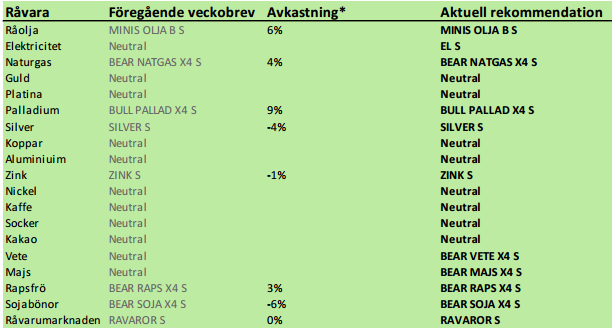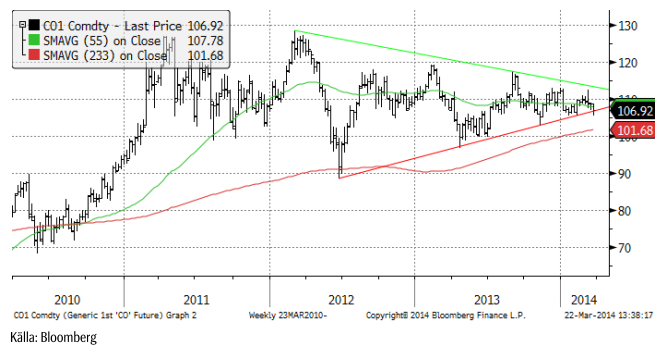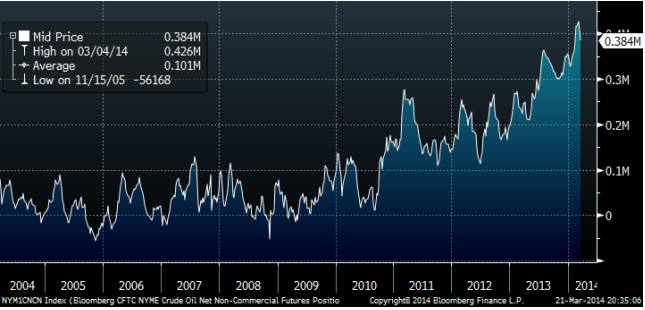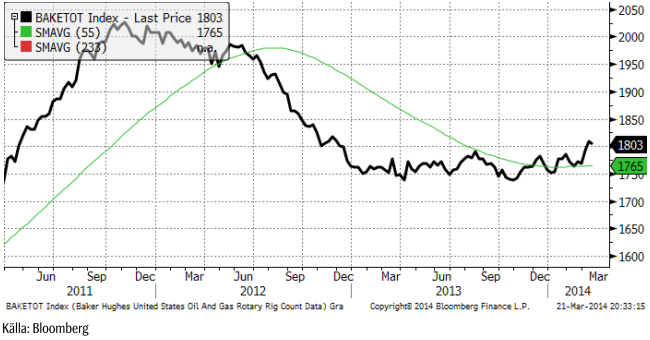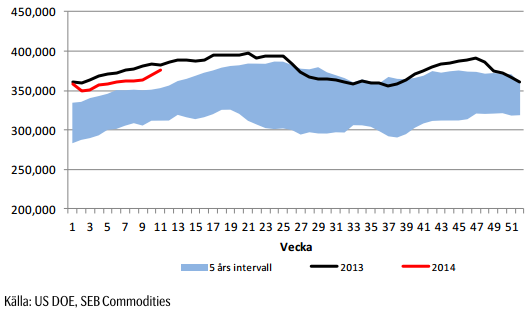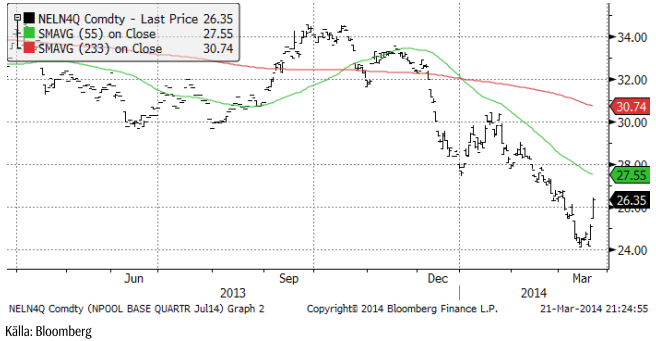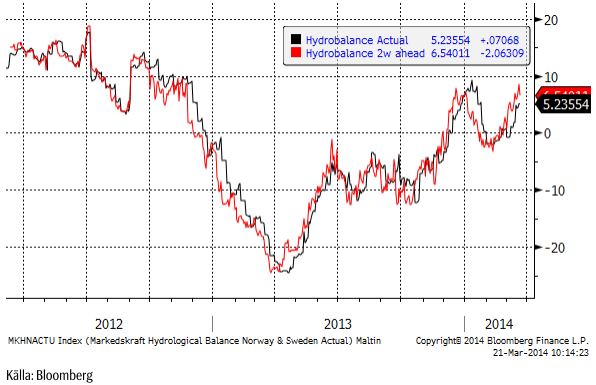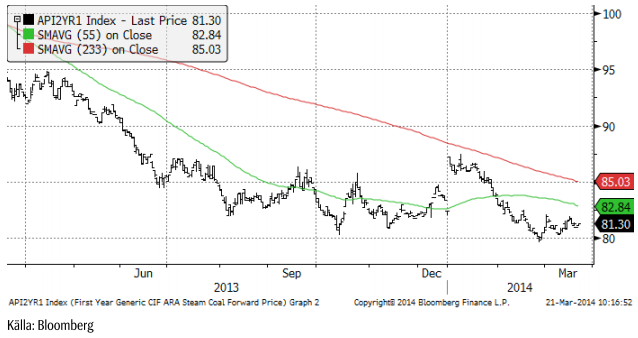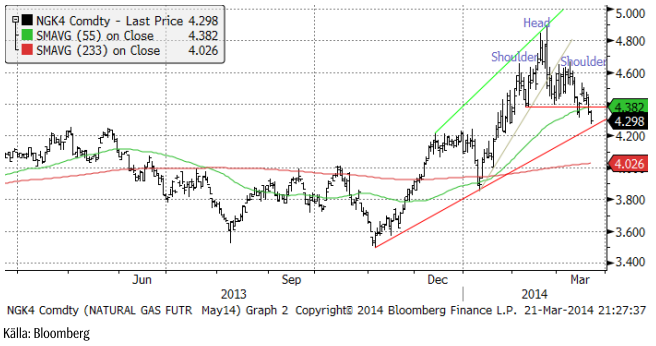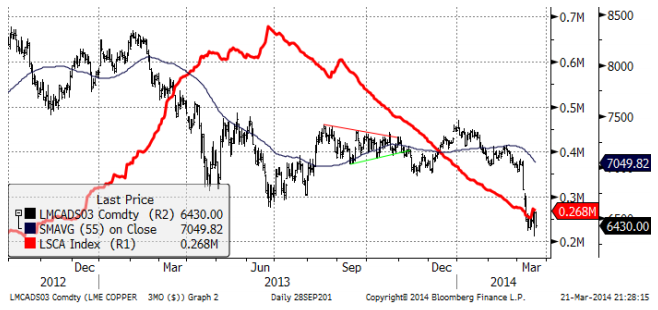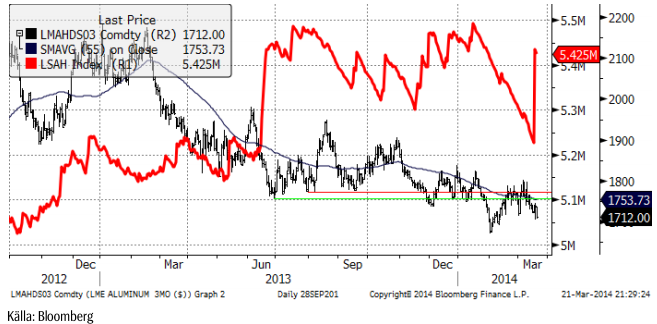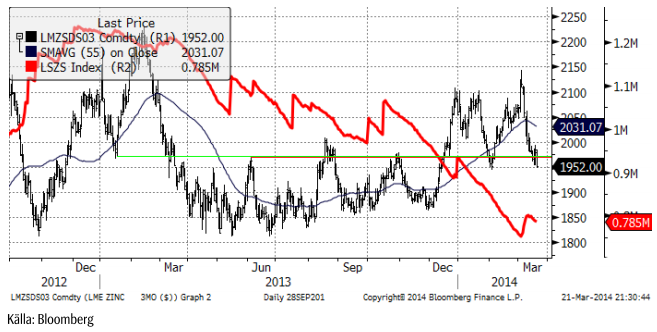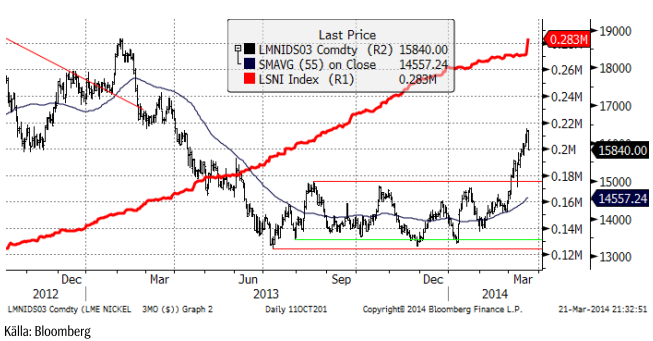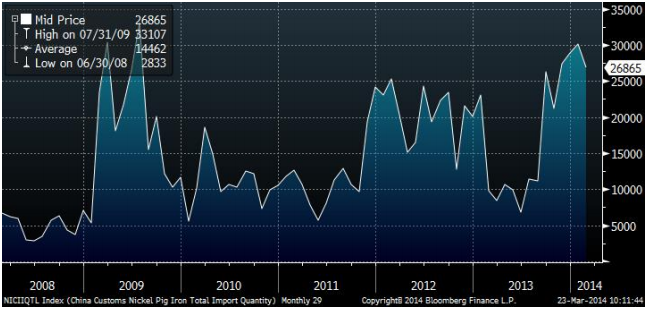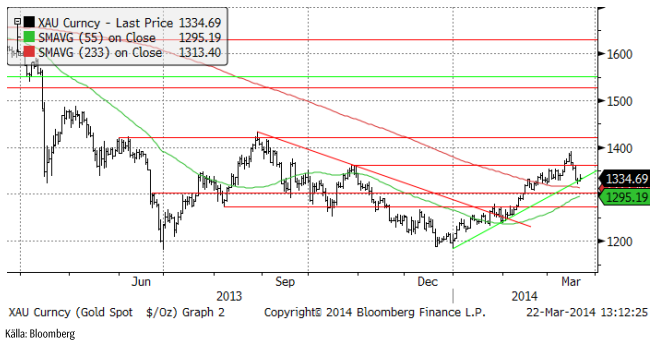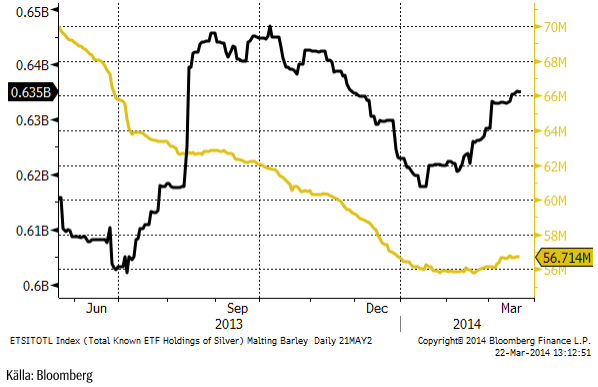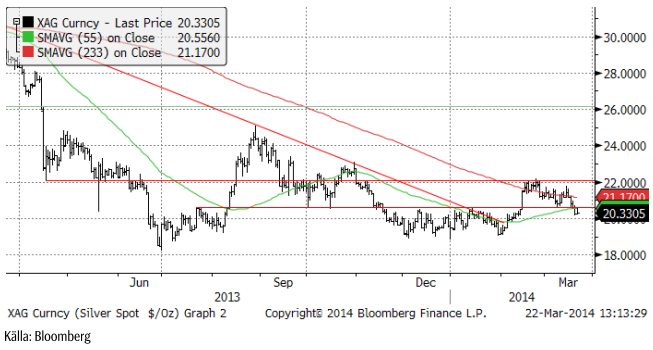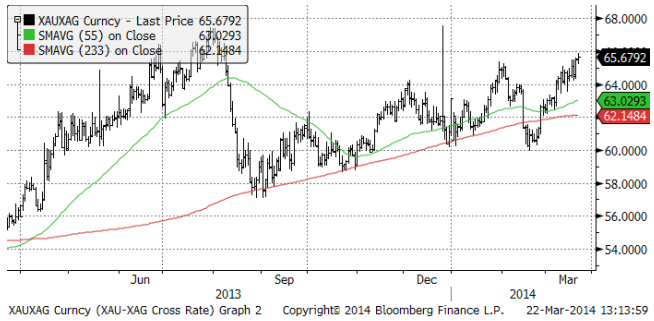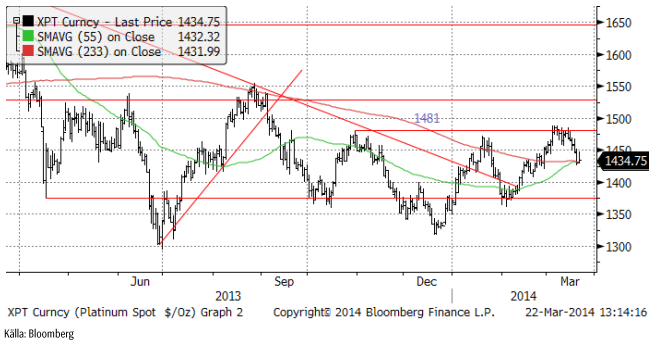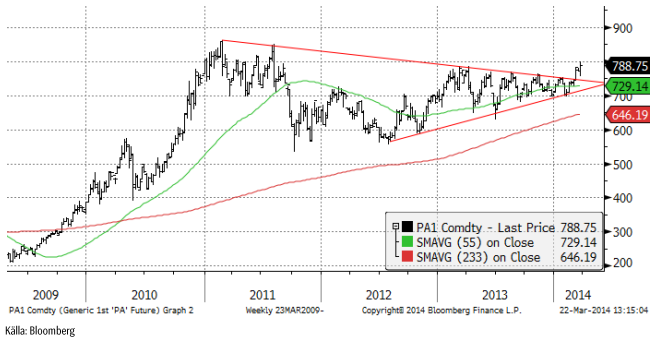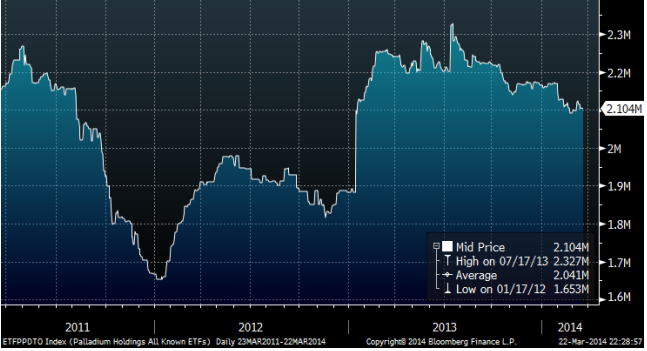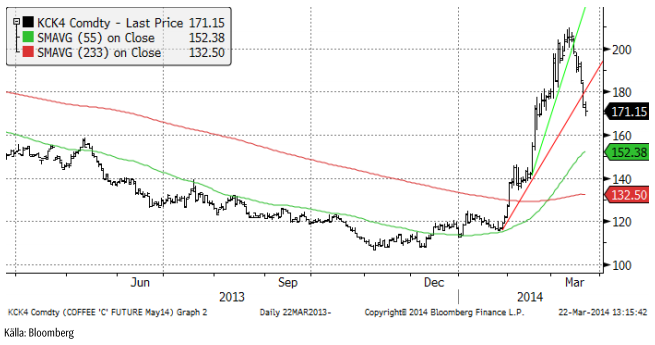Analys
SEB – Råvarukommentarer, 24 mars 2014
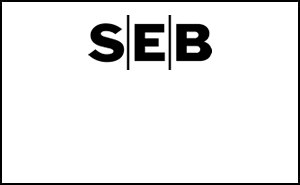
Rekommendationer
Kort sammanfattning
Palladium är den råvara vi är mest positiva till. Elpriset i Norden ser äntligen ut att ha bottnat ut och vi går över till en köprekommendation av EL S. Priset på råolja har brutit sitt tekniska stöd och kan stå inför en större trendförändring nedåt i pris.
Jordbruksprodukterna har fallhöjd och vi tror att risken är stor för fallande priser i det korta perspektivet på i princip allt. Torkan är slut i Brasilien, vilket sätter press på det upphaussade priset på kaffe och socker, men även på sojabönor och majs.
På måndagen den 31 mars publicerar USDA sin årliga ”Prospective Plantings” rapport för USA:s sådd av majs och sojabönor. Vi kommer att hålla seminerier för att gå igenom vad siffrorna säger om marknadsutvecklingen. Dessa äger rum i Malmö på tisdag nästa veckan, i Lidköping och Vadstena på onsdagen och i Stockholm på torsdagen. Inbjudna gästtalare kommer att belysa olika aspekter. I Stockholm kommer situationen i Ukrainas jordbruk att belysas av en extern expert som bedrivit storjordbruk i Ukraina.
Råolja – Brent
Oljepriset sjönk under lugn handel i veckan från 109 till 108.57 dollar per fat. Vi tror att det är lugnet före stormen, när oljepriset bryter stödet i den stora triangelformation som marknaden handlar inom.
Non-commercials (investerare) minskade sin långa position i terminskontrakt på West Texas Intermediate råolja från 407 miljoner fat till 384 miljoner fat, enligt fredagens CFTC-rapport.
Antalet borr-riggar i USA, statistik som Baker Hughes publicerar klockan 18 CET varje fredag, visar en lite nedgång från förra veckan, till 1803. Trenden till fler borr-riggar är dock tydlig, om än i ett tidigt skede.
Råoljelagren steg återigen kraftigt i veckans rapport från US Department of Energy. Vi har tidigare sagt att marknaden kommer att komma under press under det andra kvartalet, förmodligen med en ny lägstanotering på olja under april månad, lägre än förra årets botten på 97 dollar. Raffinaderierna i USA ställer om från eldningsolja / diesel till bensin nu och då efterfrågar de mindre olja, med lageruppbyggnad som konsekvens. Som vi ser ökar lageruppbyggnaden mycket snabbare nu än tidigare år, därför att utbudet är mycket större än tidigare år.
Vi rekommenderar en kort position i olja, t ex med MINIS OLJA B S eller MINIS OLJA A S.
Elektricitet
Väderleksprognosen har slagit om från blött och varmt och det innebär att den hydrologiska balansen försvagas med 1.5 TWh till +2.5 – 3 TWh enligt PointCarbon. Marknaden har legat kort och blankarna fick bråttom att köpa tillbaka kontrakt och stänga positioner, vilket gav skjuts uppåt på priset. Som vi har skrivit tidigare kan en vändning uppåt bli våldsam, när den kommer. Vi tror att vi kan ha sett botten vid 24.15 euro per MWh, strax över den jämna nivån 24 euro. Efter en så lång nedgång brukar dock aldrig priserna vända spikrakt uppåt, men vad vi tror att det kan bli oroligt och volatilt den närmaste tiden.
Priset är så lågt ändå, att vi går över från neutral rekommendation till rekommendation att köpa EL S. Det är lite för volatilt för att rekommendera BULL-certifikat.
En risk för framtiden är den massiva utbyggnaden av framförallt solkraft i Tyskland, som en solig dag kan generera kraft motsvarande ca 35 kärnreaktorer (35 GigaWatt), alltså ca 3.5 gånger den svenska kärnkraften. Denna el erbjuds marknaden till noll euro, eftersom det är den rörliga kostnaden.
Markedskrafts 2 veckors prognos för hydrologisk balans har till fredagens morgon sjunkit från 8.6 till 6.5 TWh, som vi ser i diagrammet nedan.
Priset på kol har stabiliserat sig.
Vi går alltså över till köprekommendation från neutral och rekommenderar EL S.
Naturgas
Förra veckan rekommenderade vi köp av BEAR NATGAS X4 S mot bakgrund av att priset stigit en längre tid på det kalla vädret i USA och att varmt väder nu ”borde” komma in i prognosfönstret. Samtidigt såg vi att antalet borr-riggar återigen ökar tydligt och de flesta av dem producerar gas. Japan drar igång sina kärnkraftverk nu och slutar därmed att importera LNG. Det har talats om, bland annat i en annons i New York Times i fredags som en privatperson (!) satt in med anledning av krisen i Ukraina, att EU skulle importera LNG från USA. Om det sker, som en del i det ”paket” som EU och USA ställer upp mot Ryssland efter söndagens ”val” i södra Ukraina, kan det verka stödjande på priset, men annars bör priset i första hand falla ner mot 4.30 – 4.20 dollar per MMBtu. Vi fortsätter med säljrekommendation och behåller BEAR NATGAS X4 S.
Koppar
Kopparpriset stängde ner 34 dollar på veckan till 6430 dollar. Marknaden har handlat ner kopparpriset efter oro för att tillväxten dämpas när USA:s centralbank börjar höja räntan igen. FED publicerade en prognos i veckan som gick att räntan kommer att vara 1% mot slutet av nästa år och 2.25% om två år. Tekniskt motstånd finns nu på 6750 dollar. Ur ett tekniskt perspektiv är det, trots fyndköpsrekommendationerna som förekommer i emailade snabbkommenterar från olika banker, större risk för fortsatt nedgång i det korta perspektivet, än att priserna återgår till 7000 dollar.
Vi fortsätter att rekommendera neutral position i koppar.
Aluminium
Aluminiumpriset sjönk i veckan från 1740 till 1712 och har inte drabbats lika hårt som t ex kopparmarknaden av de senaste negativa makroekonomiska signalerna. Det beror på att marknaden redan är tämligen pressad i botten. Däremot kan vi inte heller se någon anledning att idag köpa aluminium.
Vi fortsätter med neutral rekommendation på aluminium.
Zink
Zinkrpriset sjönk i veckan från 1980 till 1952 dollar per ton. Den tekniska stödnivån vid 1950 – 1970 dollar per ton verkar än så länge hålla. Så länge den gör det, kan man våga sig på att vara köpt zink, men om priset skulle bryta ner, under 1950 dollar, bör man snabbt ta en stopp-loss.
Vi rekommenderar köp av ZINK S eller BULL ZINK X4 S.
Nickel
Nickel steg faktiskt med 100 dollar per ton från 15740 till 15840 i veckan som gick. Vi ser inflöden i våra NICKEL S och BULL NICKEL X4 S. Detsamma ser vi i intresset för att investera i nickel generellt. På global basis uppvisar vissa fysiskt backade börshandlade investeringsprodukter på nickel en fördubbling av antalet ton som investerare är köpta.
Med det sagt, ”borde” det komma en rekyl nedåt nu, eftersom priset har gått upp kraftigt och 16,500 dollar är ett tekniskt motstånd, där det funnits säljare, uppenbarligen.
Vi rekommenderar att man kortsiktigt tar hem vinster och försöker köpa igen till lägre pris. Långsiktigt är vi positiva till nickel och behåller den långsiktiga köprekommendationen på nickel.
Indonesiens exportförbud av obearbetad nickelmalm har inneburit att Kinas import av Nickel Pig Iron (NPI) har skjutit i höjden. Vi ser en bild på kinas import nedan. 26,865 ton importerades alltså i januari, enligt statistik som publicerades i februari av den kinesiska tullen.
Guld
Guldpriset som föll kraftigt efter motstånd vid 1400 dollar, stängde upp i fredags. Priset föll tidigare i veckan efter att FED:s chef Janet Yellen i ett tal talat om prognosen för när räntorna ska börja höjas i USA. I fredags annekterade Ryssland Krim och EU gjorde en politisk överenskommelse om stöd till Ukraina. USA skärpte sanktionerna mot ryska politiker och affärsmän med koppling till Putin; i praktiken de personer som kontrollerar stora delar av ryskt näringsliv. Guldpriset reagerar positivt på geopolitisk oro. De enda länder som ställt sig på Rysslands sida och erkänt Krim, är Nordkorea och Syrien, världens främsta skurkstater. Det är rent objektivt sett ett passande sällskap för Ryssland. Ryssland har visat för alla att internationell lag inte gäller för dem. På sociala medier har Ryssland med råge återfått positionen som ”the Evil Empire”, som USA:s förre president Ronald Reagan kallade det. USA är dock mycket svagare än då, både politiskt, ekonomiskt och militärt eftersom det är upptaget på olika håll i världen i sitt krig mot terrorismen. Det är en ny verklighet och guldpriset anpassar sig till det när investerare ser över sina placeringar.
Med det sagt, 1400 dollar var ett för starkt motstånd – den här gången, men trendstödet för uppgången är inte bruten. Skulle priset på guld falla det lilla minsta i veckan som kommer, bryts dock detta, och vi får en rekyl, förmodligen ner mot 1300, kanske ända ner mot prisnivåerna från slutet av januari.
ETF-köpare har avvaktat den senaste veckan. Det har inte kommit in mer pengar i ETF:er som placerar i fysiskt guld. Däremot har ETF-er på silver attraherat köpare, förmodligen för att priset på silver har backat mer än priset på guld.
Vi fortsätter tills vidare med neutral vy på guld. Vi skulle vilja köpa om det kommer en rekyl.
Silver
Silverpriset föll under prisintervallet på 20.50 till 22. Marknaden har, som jag skrev förra veckan, ingen trend – än. Vänder priset upp från den här nivån och går över 22 dollar, har vi en stigande trend. Annars lutar det mest åt fortsatt trendlöshet.
Som vi såg av ETF-innehaven i silver ovan, attraherar silver köpare som tycker att priset är lågt. Det är inte trend-investerare, utan värde-investerare. Nedan ser vi guldpriset angivet i silver (istället för dollar). Vi ser att guld är relativt dyrt i förhållande till silver, såväl i det korta perspektivet som i det långa. Vi föredrar därför att köpa silver, hellre än guld av den anledningen, men just nu ser vi inte någon omedelbar anledning att göra det. Palladium tror vi är en betydligt bättre placering.
Vi anser att silver är mer köpvärt än guld och skulle vilja köpa på de här nivåerna, i synnerhet efter den rekyl som inträffat de senaste veckorna.
Platina & Palladium
Som vi skrev förra veckan fanns en risk för en rekyl nedåt i priset på platina och vi valde att ha neutral position. Det har nåtts en viss överenskommelse mellan gruvfack och gruvbolag, men det gäller bara en liten del av arbetsstyrkan vid gruvorna, de som är bäst betalda. Detta betyder inte att konflikten är över. Det ska bli intressant att se om priset på platina vänder upp från den här nivån. I så fall ser skulle bilden av en marknad som håller på att skapa och inleda en stigande pristrend stärkas. Priset måste bryta motståndsnivån 1481 för att bekräfta detta.
Vi skrev förra veckan att rekylen nedåt efter utbrottet från triangelformationen är klassisk. Vi skrev att vi ville se en bekräftelse på utbrottet genom att priset skulle passera förra årets topp på 785 dollar. Det har vi nu. Priset stängde i fredags på 788 dollar. Vi har alltså med hög sannolikhet en rejäl ”bull market” i palladium framför oss.
Efterfrågan på palladium väntas överstiga produktionen i år med mellan 780,000 och 1 miljon uns, enligt olika bedömare. Ryssland och Sydafrika står för 80% av global produktion enligt Johnsson Matthey i London. Det finns en oro för att de ekonomiska sanktionerna mot Ryssland efter kriget och invasionen av Ukraina ska påverka produktions- och exportmöjligheterna av palladium. Det är oroligt även i Sydafrika, där arbetsmarknadskonflikten vid landets gruvor ännu inte efter sex månaders konflikt har lösts.
Alla kända fysiskt backade ETF:er innehar för närvarande 2.1 miljoner uns palladium. I diagrammet nedan ser vi hur dessa innehav har förändrat sig de senaste två åren. Det har alltså varit utflöden på 200,000 uns sedan sommaren förra året.
Absa Bank, en del av Barclays, kommer att notera en ny fysiskt backad ETF i Johannesburg den 27 mars. Den ska enbart investera i palladium från Sydafrika, vilket drar undan material från det ena av de två länder som står för 80% av global produktion. Om ETF-marknaden attraherar mer investerare dras ytterligare material undan, vilket skapar ett ännu större underskott i år. Hittills har ETF:erna verkat stabiliserande på priset, men en stadig hausse kan locka till sig köpare av en ny kategori.
Vi rekommenderar alltså en neutral position i platina och en köpt position i palladium.
Kaffe
Torkan i Brasilien är av allt att döma slut. Det har regnat i veckan som gått. Prognosen från GFS-modellen för de kommande två veckorna visar onormalt mycket nederbörd över Minas Gerais. Det har regnat ordentligt och detta borde hindra ytterligare skador och reparera de som blivit; dock inte på årets skörd. Skadorna på bönorna är permanenta.
Det har varit torrt även i Vietnam, som är världens ledande producent av robusta. The Vietnam Coffee and Cocoa Association, Vicofa, sade att skörden, som börjar i oktober, väntas bli lägre än förra årets. Det är vanligtvis torrt så här års och normalt sett inget som skadar odlingen, men det har varit lite torrare än normalt. Nu väntas det även komma regn till Vietnams kaffedistrikt, som ligger uppe i bergen mot Laos. Lantbrukarna har hållit tillbaka försäljningen av vinterns skörd i avvaktan på hur det skulle gå i Brasilien. Lagren per den 7 mars var rekordhöga.
Vi rekommenderar neutral position i kaffe, eller möjligtvis en mycket kortsiktig kort position.
Kakao
Priset på kakao i New York backade i veckan från 2997 dollar per ton till 2957 dollar.
Kakaoterminsmarknaden präglas av en stor kort position i producentledet. Enligt fredagens Commitment of Traders – rapport från CFTC, som visar läget per i tisdags, har investerare minskat sin köpta position från 80,598 kontrakt förra veckan till 67,690 kontrakt den här veckan. Investerarnas sentiment fortsätter alltså att bli mindre positivt.
Kakaoterminerna på LIFFE i London handlas normalt sett högre än terminerna på NYBOT i New York. I diagrammet nedan har vi kvoten mellan London-kakao och New York-kakao, omräknat till brittiska pund per ton. Det är spotkontraktet vi ser.
Vi rekommenderar en neutral position vid dagens situation.
[box]SEB Veckobrev Veckans råvarukommentar är producerat av SEB Merchant Banking och publiceras i samarbete och med tillstånd på Råvarumarknaden.se[/box]
Disclaimer
The information in this document has been compiled by SEB Merchant Banking, a division within Skandinaviska Enskilda Banken AB (publ) (“SEB”).
Opinions contained in this report represent the bank’s present opinion only and are subject to change without notice. All information contained in this report has been compiled in good faith from sources believed to be reliable. However, no representation or warranty, expressed or implied, is made with respect to the completeness or accuracy of its contents and the information is not to be relied upon as authoritative. Anyone considering taking actions based upon the content of this document is urged to base his or her investment decisions upon such investigations as he or she deems necessary. This document is being provided as information only, and no specific actions are being solicited as a result of it; to the extent permitted by law, no liability whatsoever is accepted for any direct or consequential loss arising from use of this document or its contents.
About SEB
SEB is a public company incorporated in Stockholm, Sweden, with limited liability. It is a participant at major Nordic and other European Regulated Markets and Multilateral Trading Facilities (as well as some non-European equivalent markets) for trading in financial instruments, such as markets operated by NASDAQ OMX, NYSE Euronext, London Stock Exchange, Deutsche Börse, Swiss Exchanges, Turquoise and Chi-X. SEB is authorized and regulated by Finansinspektionen in Sweden; it is authorized and subject to limited regulation by the Financial Services Authority for the conduct of designated investment business in the UK, and is subject to the provisions of relevant regulators in all other jurisdictions where SEB conducts operations. SEB Merchant Banking. All rights reserved.
Analys
Tightening fundamentals – bullish inventories from DOE

The latest weekly report from the US DOE showed a substantial drawdown across key petroleum categories, adding more upside potential to the fundamental picture.

Commercial crude inventories (excl. SPR) fell by 5.8 million barrels, bringing total inventories down to 415.1 million barrels. Now sitting 11% below the five-year seasonal norm and placed in the lowest 2015-2022 range (see picture below).
Product inventories also tightened further last week. Gasoline inventories declined by 2.1 million barrels, with reductions seen in both finished gasoline and blending components. Current gasoline levels are about 3% below the five-year average for this time of year.
Among products, the most notable move came in diesel, where inventories dropped by almost 4.1 million barrels, deepening the deficit to around 20% below seasonal norms – continuing to underscore the persistent supply tightness in diesel markets.
The only area of inventory growth was in propane/propylene, which posted a significant 5.1-million-barrel build and now stands 9% above the five-year average.
Total commercial petroleum inventories (crude plus refined products) declined by 4.2 million barrels on the week, reinforcing the overall tightening of US crude and products.


Analys
Bombs to ”ceasefire” in hours – Brent below $70

A classic case of “buy the rumor, sell the news” played out in oil markets, as Brent crude has dropped sharply – down nearly USD 10 per barrel since yesterday evening – following Iran’s retaliatory strike on a U.S. air base in Qatar. The immediate reaction was: “That was it?” The strike followed a carefully calibrated, non-escalatory playbook, avoiding direct threats to energy infrastructure or disruption of shipping through the Strait of Hormuz – thus calming worst-case fears.

After Monday morning’s sharp spike to USD 81.4 per barrel, triggered by the U.S. bombing of Iranian nuclear facilities, oil prices drifted sideways in anticipation of a potential Iranian response. That response came with advance warning and caused limited physical damage. Early this morning, both the U.S. President and Iranian state media announced a ceasefire, effectively placing a lid on the immediate conflict risk – at least for now.
As a result, Brent crude has now fallen by a total of USD 12 from Monday’s peak, currently trading around USD 69 per barrel.
Looking beyond geopolitics, the market will now shift its focus to the upcoming OPEC+ meeting in early July. Saudi Arabia’s decision to increase output earlier this year – despite falling prices – has drawn renewed attention considering recent developments. Some suggest this was a response to U.S. pressure to offset potential Iranian supply losses.
However, consensus is that the move was driven more by internal OPEC+ dynamics. After years of curbing production to support prices, Riyadh had grown frustrated with quota-busting by several members (notably Kazakhstan). With Saudi Arabia cutting up to 2 million barrels per day – roughly 2% of global supply – returns were diminishing, and the risk of losing market share was rising. The production increase is widely seen as an effort to reassert leadership and restore discipline within the group.
That said, the FT recently stated that, the Saudis remain wary of past missteps. In 2018, Riyadh ramped up output at Trump’s request ahead of Iran sanctions, only to see prices collapse when the U.S. granted broad waivers – triggering oversupply. Officials have reportedly made it clear they don’t intend to repeat that mistake.
The recent visit by President Trump to Saudi Arabia, which included agreements on AI, defense, and nuclear cooperation, suggests a broader strategic alignment. This has fueled speculation about a quiet “pump-for-politics” deal behind recent production moves.
Looking ahead, oil prices have now retraced the entire rally sparked by the June 13 Israel–Iran escalation. This retreat provides more political and policy space for both the U.S. and Saudi Arabia. Specifically, it makes it easier for Riyadh to scale back its three recent production hikes of 411,000 barrels each, potentially returning to more moderate increases of 137,000 barrels for August and September.
In short: with no major loss of Iranian supply to the market, OPEC+ – led by Saudi Arabia – no longer needs to compensate for a disruption that hasn’t materialized, especially not to please the U.S. at the cost of its own market strategy. As the Saudis themselves have signaled, they are unlikely to repeat previous mistakes.
Conclusion: With Brent now in the high USD 60s, buying oil looks fundamentally justified. The geopolitical premium has deflated, but tensions between Israel and Iran remain unresolved – and the risk of missteps and renewed escalation still lingers. In fact, even this morning, reports have emerged of renewed missile fire despite the declared “truce.” The path forward may be calmer – but it is far from stable.
Analys
A muted price reaction. Market looks relaxed, but it is still on edge waiting for what Iran will do

Brent crossed the 80-line this morning but quickly fell back assigning limited probability for Iran choosing to close the Strait of Hormuz. Brent traded in a range of USD 70.56 – 79.04/b last week as the market fluctuated between ”Iran wants a deal” and ”US is about to attack Iran”. At the end of the week though, Donald Trump managed to convince markets (and probably also Iran) that he would make a decision within two weeks. I.e. no imminent attack. Previously when when he has talked about ”making a decision within two weeks” he has often ended up doing nothing in the end. The oil market relaxed as a result and the week ended at USD 77.01/b which is just USD 6/b above the year to date average of USD 71/b.

Brent jumped to USD 81.4/b this morning, the highest since mid-January, but then quickly fell back to a current price of USD 78.2/b which is only up 1.5% versus the close on Friday. As such the market is pricing a fairly low probability that Iran will actually close the Strait of Hormuz. Probably because it will hurt Iranian oil exports as well as the global oil market.
It was however all smoke and mirrors. Deception. The US attacked Iran on Saturday. The attack involved 125 warplanes, submarines and surface warships and 14 bunker buster bombs were dropped on Iranian nuclear sites including Fordow, Natanz and Isfahan. In response the Iranian Parliament voted in support of closing the Strait of Hormuz where some 17 mb of crude and products is transported to the global market every day plus significant volumes of LNG. This is however merely an advise to the Supreme leader Ayatollah Ali Khamenei and the Supreme National Security Council which sits with the final and actual decision.
No supply of oil is lost yet. It is about the risk of Iran closing the Strait of Hormuz or not. So far not a single drop of oil supply has been lost to the global market. The price at the moment is all about the assessed risk of loss of supply. Will Iran choose to choke of the Strait of Hormuz or not? That is the big question. It would be painful for US consumers, for Donald Trump’s voter base, for the global economy but also for Iran and its population which relies on oil exports and income from selling oil out of that Strait as well. As such it is not a no-brainer choice for Iran to close the Strait for oil exports. And looking at the il price this morning it is clear that the oil market doesn’t assign a very high probability of it happening. It is however probably well within the capability of Iran to close the Strait off with rockets, mines, air-drones and possibly sea-drones. Just look at how Ukraine has been able to control and damage the Russian Black Sea fleet.
What to do about the highly enriched uranium which has gone missing? While the US and Israel can celebrate their destruction of Iranian nuclear facilities they are also scratching their heads over what to do with the lost Iranian nuclear material. Iran had 408 kg of highly enriched uranium (IAEA). Almost weapons grade. Enough for some 10 nuclear warheads. It seems to have been transported out of Fordow before the attack this weekend.
The market is still on edge. USD 80-something/b seems sensible while we wait. The oil market reaction to this weekend’s events is very muted so far. The market is still on edge awaiting what Iran will do. Because Iran will do something. But what and when? An oil price of 80-something seems like a sensible level until something do happen.
-

 Nyheter4 veckor sedan
Nyheter4 veckor sedanStor uppsida i Lappland Guldprospekterings aktie enligt analys
-

 Nyheter4 veckor sedan
Nyheter4 veckor sedanSilverpriset släpar efter guldets utveckling, har mer uppsida
-

 Nyheter3 veckor sedan
Nyheter3 veckor sedanUppgången i oljepriset planade ut under helgen
-

 Nyheter2 veckor sedan
Nyheter2 veckor sedanMahvie Minerals växlar spår – satsar fullt ut på guld
-

 Nyheter3 veckor sedan
Nyheter3 veckor sedanLåga elpriser i sommar – men mellersta Sverige får en ökning
-

 Analys3 veckor sedan
Analys3 veckor sedanVery relaxed at USD 75/b. Risk barometer will likely fluctuate to higher levels with Brent into the 80ies or higher coming 2-3 weeks
-

 Nyheter2 veckor sedan
Nyheter2 veckor sedanOljan, guldet och marknadens oroande tystnad
-

 Nyheter2 veckor sedan
Nyheter2 veckor sedanJonas Lindvall är tillbaka med ett nytt oljebolag, Perthro, som ska börsnoteras


